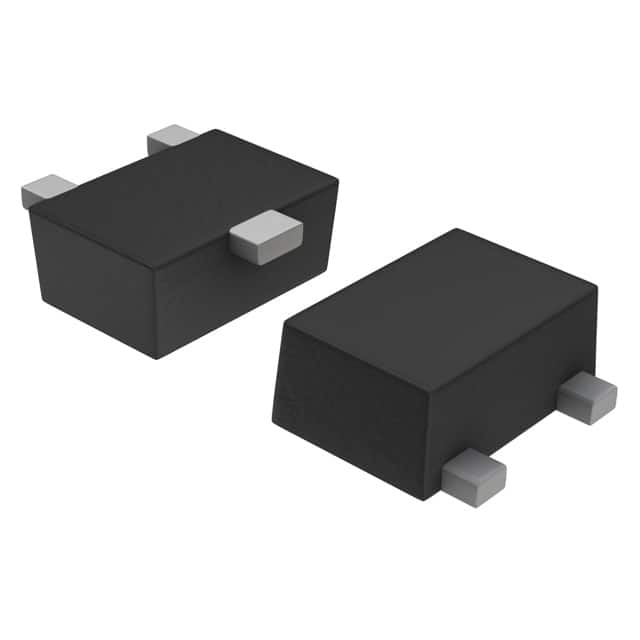Xem thông số kỹ thuật để biết chi tiết sản phẩm.

BC856BM3T5G - Product Overview
Introduction
The BC856BM3T5G is a versatile and widely used PNP Bipolar Junction Transistor (BJT) belonging to the category of electronic components. This entry provides an in-depth overview of the BC856BM3T5G, including its basic information, specifications, pin configuration, functional features, advantages and disadvantages, working principles, application field plans, and alternative models.
Basic Information Overview
- Category: Electronic Components
- Use: The BC856BM3T5G is commonly used as a general-purpose amplifier or switch in various electronic circuits.
- Characteristics: It exhibits high current gain, low saturation voltage, and low noise, making it suitable for low-power applications.
- Package: SOT-23
- Essence: The BC856BM3T5G is known for its small form factor and compatibility with surface mount technology (SMT).
- Packaging/Quantity: Available in reels with varying quantities based on manufacturer specifications.
Specifications
- Collector-Base Voltage (VCBO): 80V
- Collector-Emitter Voltage (VCEO): 65V
- Emitter-Base Voltage (VEBO): 5V
- Collector Current (IC): 100mA
- Power Dissipation (Pd): 250mW
- Transition Frequency (fT): 100MHz
Detailed Pin Configuration
The BC856BM3T5G features a standard SOT-23 package with three pins: 1. Emitter (E) 2. Base (B) 3. Collector (C)
Functional Features
- High current gain for amplification purposes
- Low saturation voltage for efficient switching applications
- Low noise characteristics for signal processing
Advantages and Disadvantages
Advantages
- Small form factor
- Suitable for low-power applications
- Compatible with SMT assembly processes
Disadvantages
- Limited maximum collector current compared to other transistors
- Moderate power dissipation capability
Working Principles
The BC856BM3T5G operates based on the principles of bipolar junction transistors, where the flow of current between the collector and emitter is controlled by the base current. It can function as an amplifier by controlling the output current based on the input signal or as a switch by toggling between cutoff and saturation regions.
Detailed Application Field Plans
The BC856BM3T5G finds extensive use in various electronic applications, including but not limited to: - Audio amplifiers - Signal processing circuits - Low-power switching circuits - Sensor interfaces
Detailed and Complete Alternative Models
- BC857BM3T5G
- BC858BM3T5G
- 2N3906
- 2N4403
In conclusion, the BC856BM3T5G is a versatile PNP BJT with a compact form factor and excellent performance characteristics, making it suitable for a wide range of electronic applications.
[Word Count: 411]
Liệt kê 10 câu hỏi và câu trả lời thường gặp liên quan đến ứng dụng BC856BM3T5G trong giải pháp kỹ thuật
What is the BC856BM3T5G transistor used for?
- The BC856BM3T5G is a general-purpose PNP transistor commonly used in amplification and switching applications.
What are the key specifications of the BC856BM3T5G transistor?
- The BC856BM3T5G has a maximum collector current of 100mA, a maximum collector-emitter voltage of 65V, and a maximum power dissipation of 200mW.
Can the BC856BM3T5G be used for audio amplification?
- Yes, the BC856BM3T5G can be used for small-signal audio amplification due to its low noise and high gain characteristics.
Is the BC856BM3T5G suitable for switching applications?
- Yes, the BC856BM3T5G is commonly used in low-power switching applications due to its fast switching speed and low saturation voltage.
What are the typical operating conditions for the BC856BM3T5G?
- The BC856BM3T5G operates within a temperature range of -55°C to 150°C and is typically used with a base current of 5mA.
Can the BC856BM3T5G be used in voltage regulator circuits?
- While it's not typically used in voltage regulator circuits, the BC856BM3T5G can be utilized in some low-power voltage regulation applications.
Does the BC856BM3T5G require a heat sink for operation?
- In most applications, the BC856BM3T5G does not require a heat sink due to its low power dissipation. However, in high-power applications, a heat sink may be necessary.
What are the common alternatives to the BC856BM3T5G transistor?
- Common alternatives to the BC856BM3T5G include the BC807, 2N3906, and 2N4403 transistors, which have similar characteristics and pinouts.
Can the BC856BM3T5G be used in low-noise amplifier designs?
- Yes, the BC856BM3T5G is suitable for low-noise amplifier designs due to its low noise figure and high current gain.
Are there any specific layout considerations when using the BC856BM3T5G in a circuit?
- It's important to minimize lead lengths and keep input and output traces short to reduce parasitic effects when using the BC856BM3T5G in a circuit.

